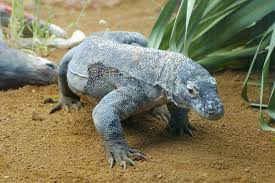🦎 Introduction: A Bloody Misunderstanding
Komodo dragons are the stuff of legends—massive, prehistoric-looking reptiles that roam the islands of Indonesia with a quiet menace. But what happens when modern human hygiene meets ancient predator instincts? Specifically, what happens when menstruating travelers visit Komodo Island?
The question, “Can Komodo dragons smell period blood?” isn’t just a quirky curiosity—it’s a serious safety concern. The answer is yes, and it’s why tampons and Komodo dragons don’t mix.
🔬 The Biology Behind the Beast
Komodo dragons (Varanus komodoensis) are the largest living lizards on Earth, growing up to 10 feet long and weighing over 150 pounds. Native to a handful of Indonesian islands, including Komodo, Rinca, Flores, and Gili Motang, these reptiles are apex predators with no natural enemies.
What makes them especially dangerous is their extraordinary sense of smell. Komodo dragons use a specialized organ called the Jacobson’s organ, located in the roof of their mouth, to detect scent particles. By flicking their forked tongue, they collect these particles and analyze them to locate prey—even from miles away.
This olfactory superpower allows them to detect blood, decaying flesh, and other biological markers with astonishing accuracy. And yes, that includes menstrual blood.
🩸 Can Komodo Dragons Smell Period Blood?
Scientific studies and anecdotal evidence from park rangers and biologists confirm that Komodo dragons can detect the scent of menstrual blood. While period blood differs slightly from blood due to injury or death, it still contains enough biological markers—iron, hemoglobin, and pheromones—to trigger a Komodo dragon’s hunting instincts.
In fact, Komodo dragons have been known to follow the scent trail of injured animals for hours. If they can detect a drop of blood from a wounded deer, it’s not a stretch to believe they can sense menstrual blood from a human.
🚫 Why Tampons Aren’t a Shield
Many travelers assume that using tampons or menstrual cups will mask the scent of menstruation. Unfortunately, that’s not the case. Tampons may contain the flow, but they don’t eliminate the odor. The presence of blood-soaked material inside the body can still emit scent particles that Komodo dragons can detect.
Moreover, tampons are not airtight. They allow microscopic scent molecules to escape, especially in hot, humid environments like Komodo Island. This means that even with a tampon, a menstruating person may still be at risk.
🏝️ Visiting Komodo Island While Menstruating
Tour guides in Komodo National Park often advise menstruating individuals to avoid close encounters with Komodo dragons. While attacks are rare, the risk is real enough that safety protocols exist.
Some tour companies even ask female travelers to disclose if they’re menstruating before joining a trek. This isn’t discrimination—it’s a precaution based on biological reality.
If your cycle coincides with your travel dates, consider rescheduling your visit or taking extra precautions. The dragons may look slow and lazy, but they can sprint short distances at surprising speeds and have a venomous bite that causes rapid blood loss and shock.
🧭 Safety Tips for Travelers
If you’re planning a trip to Komodo Island, here are some essential safety tips:
- Inform your guide if you’re menstruating. They may adjust the itinerary or offer alternative activities.
- Avoid wearing scented products, perfumes, or lotions that could attract attention.
- Stay in groups and follow all safety instructions. Komodo dragons are less likely to approach large groups.
- Keep a safe distance—at least 6 meters (20 feet) from any dragon.
- Don’t carry food or anything with a strong smell in your backpack.
- Wear neutral-colored clothing to avoid standing out.
- Avoid squatting or sitting near bushes or rocks where dragons may be hiding.
🧪 What Science Says About Komodo Dragon Behavior
Komodo dragons are opportunistic hunters. They prefer easy prey—injured animals, carrion, or anything that smells like it’s dying. Their bite delivers venom that lowers blood pressure and prevents clotting, making it easier for them to track and kill their prey.
Interestingly, Komodo dragons don’t rely solely on sight or sound. Their sense of smell is their primary hunting tool. They can detect carrion from up to 9 kilometers (5.6 miles) away. That’s why menstruation, even if concealed, can be a risk factor.
🌍 Cultural Awareness and Local Wisdom
In Indonesia, local communities have long understood the dangers of Komodo dragons. Villagers avoid certain areas during menstruation and teach their children to respect the dragons’ territory.
Tourism has brought new challenges. Many visitors are unaware of the risks and treat Komodo dragons like zoo animals. But these creatures are wild, unpredictable, and capable of killing a human in minutes.
Respecting local wisdom isn’t just polite—it’s life-saving.
🧳 What to Pack (and What to Leave Behind)
If you’re visiting Komodo Island, here’s a quick checklist:
Pack:
- Unscented menstrual products (pads, tampons, cups)
- Neutral-colored clothing
- Sturdy hiking shoes
- Water bottle
- Sunscreen and insect repellent (unscented)
Avoid:
- Perfumes and scented lotions
- Bright or flashy clothing
- Food with strong odors
- Open wounds or bandages
🧠 Myth vs. Reality
Let’s bust a few myths:
- Myth: “Komodo dragons are slow and lazy.” Reality: They can run up to 13 mph in short bursts.
- Myth: “Tampons make you invisible to predators.” Reality: Tampons don’t block scent molecules.
- Myth: “Komodo dragons don’t attack humans.” Reality: Attacks are rare but documented. In 2009, a Komodo dragon attacked a park ranger inside his office.
🧬 Evolutionary Perspective
From an evolutionary standpoint, Komodo dragons developed their keen sense of smell to survive in harsh island environments. With limited prey, they had to become efficient hunters. Their ability to detect blood—even menstrual blood—is a survival trait.
Humans, on the other hand, evolved hygiene products to manage menstruation discreetly. But these products weren’t designed with apex predators in mind.
🧘 Emotional Impact and Travel Anxiety
For menstruating travelers, the fear of being targeted by a Komodo dragon can cause anxiety. It’s important to acknowledge these feelings and plan accordingly. Speak with your tour guide, ask questions, and don’t hesitate to opt out of risky activities.
Your safety is more important than a photo op.
🧪 What Researchers Are Studying
Some researchers are exploring ways to mask human scent more effectively in wildlife zones. This includes developing odor-neutralizing fabrics and menstrual products designed for extreme environments.
Until then, awareness and caution remain the best tools.
🧭 Alternatives to Komodo Island
If you’re menstruating and want to avoid Komodo dragons altogether, consider visiting other parts of Indonesia:
- Bali: Known for beaches, temples, and yoga retreats.
- Lombok: Offers hiking, waterfalls, and cultural experiences.
- Sumatra: Home to orangutans and lush rainforests.
These destinations offer rich experiences without the risk of encountering blood-sniffing reptiles.
🧾 Final Thoughts: Respect the Dragon
Komodo dragons are majestic, ancient creatures that deserve respect—not fear, not selfies, and certainly not underestimation. Their ability to detect blood—including menstrual blood—makes them a unique threat to unaware tourists.
Tampons may offer convenience, but they don’t offer invisibility. When it comes to Komodo dragons, it’s better to be safe than sorry.
So if you’re planning a trip to Komodo Island, pack wisely, stay informed, and remember: nature doesn’t care about your travel itinerary. It cares about survival—and so should you.




